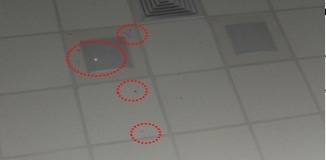Lines, dots, lights appear in photos using the camera app
Flaws such as blotches, spots, and dots can appear on your photos for a number of different reasons. Screen flickering, black lines showing up, or vibration occurring that may appear in certain conditions. However, these issues that may occur with your camera are not malfunctions. Please find out more information about such phenomena below.

The most common reasons are light phenomena or dirt on the lens
- Check your camera lens for scratches or dirt, and wipe it with a clean, damp cloth.
- If you suspect that the issue may be a hardware problem, you can run a diagnostic test.
- Be sure to check if your device's software and related apps are updated with the latest version. Please check how to update your mobile device's software.
- If the problem occurs only occasionally, or under certain conditions, it might relate to lighting phenomena.
Photography and light phenomena
Check the below common light phenomena.
Photography and light phenomena
The fluorescent lamp flashes 60 times a second depending on the AC power frequency (60 Hz).
When taking a picture or video with the camera under a fluorescent light source, a momentary flickering of light that the naked eye cannot feel may be captured, causing the image to flicker or a flicker phenomenon in which black lines appear in the picture.
This is a phenomenon according to the characteristics of the lighting, and generally does not appear in 3-wavelength fluorescent lamps, incandescent lamps, and LED lighting.

If excessive heat or high-density energy, direct sunlight is concentrated in certain areas of the camera lens, it may cause damage to the microlens on the camera. Be careful not to expose the camera lens to a strong light source, such as direct sunlight. If the camera lens is exposed to a strong light source, such as direct sunlight, the camera image sensor may be damaged. A damaged image sensor is irreparable and will cause dots or spots in pictures.

The phenomenon that appears on the camera is not faulty.
It’s a normal flare phenomenon that occurs when shooting under backlight with the sun or light located close to the screen frame or when there are fingerprint/foreign matter on the lens. It is particularly obvious when taking shoot of objects around bright lights.
To minimize the phenomenon, ensure that the sun is not too close to the screen and remove all foreign materials on the lens before taking a photo shoot. To clean the lens, wipe with a clean and soft cloth in a circular motion.

White spots on photos can be caused by light reflecting off a strong light source. It commonly appears when taking images around bright lights. To reduce light reflections, check the lighting when taking your photos.

This is a Black Sun phenomenon that occurs when part of the photo is overexposed to light. It most commonly happens when taking a picture directly aimed at an extremely bright light source such as the Sun.
This is a normal operation that can happen on all cameras with CMOS sensors. We recommend to change a lower exposure value (*Exposure determines how much light the camera’s sensor receives)

The Dynamic AMOLED display of your device is more vivid, more expressive, and more accurate in color than conventional LCDs or AMOLEDs, and it can allow more subtle color changes to be visible.
If there aren’t big differences in color while you're looking at regular images or videos, it's not a device defect.
This is called the Moire phenomenon and may appear due to interference between the image sensor’s pixel and display pixel. This may also appear due to interference between the image sensor’s pixel and objects with periodic patterns such as mosquito nets. In addition, even if there is no periodic pattern on the subject, it may occur if there is a sloped subject vertical or horizontal to the image sensor.
To prevent this Moire phenomenon, we recommend adjusting the distance between the device and objects or shooting angle. Or, if you change the screen resolution while viewing the screen, the symptom may disappear as well.
Light leakage is a natural phenomenon in which light from the screen is propagated inside the cover glass and reflected on the case metal (Waveguide phenomenon). Especially in the case metal products with high gloss, this phenomenon can be more visible, and it tends to look more obscure in a dark environment with clear light and darkness.
This is the phenomenon caused by the transmission of light, and there is no problem with the structural functions such as the gap, water-resistance performance of the product, so please use it safely.
Streaks on Super slow motion video are caused by the flicker of the light source. As Super slow motion use very fast shutter speed, a flash of light that is invisible to the human being is recorded on the camera. And it appears shape of the line in the characteristics of the camera (CMOS) sensor. When using Super slow motion under a flashlight source, the line appears differently according to the shooting direction of the camera.
For example, when you placed the phone vertically, a flashing line appears vertically.
In case the bandwidth of the line is influenced by the flicker frequency of the light source. The usual light source flashes at 120Hz and there are various light sources with different frequencies. In this case bandwidth of streaks is shown differently.
Thank you for your feedback!
Please answer all questions.




